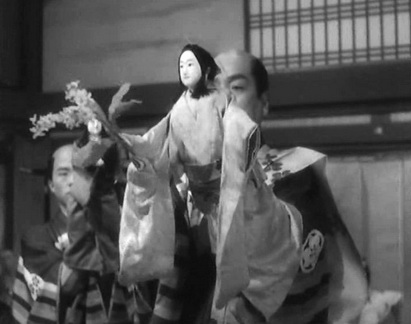
Bunraku: Japanese Traditional Puppetry
Bunraku (or Ningyō jōruri) is one of the three major classical theaters of Japan. It is considered the most highly developed form of puppetry in the world. The puppets range in size from two and a half feet to four feet tall, or more. With such big puppets, the performance is usually outdoors. Taiko drummers usually accompany the bunraku to further enhance the performance, along with a chanter and a shamisen player.
Screenshot from The Life of Oharu, 1952 film.
History
Bunraku was formed during the Edo Period (1600-1868) in Osaka, and was most popular among the Japanese common folk. It flourished in the latter part of the 17th century with the emergence of the popular chanters Takemoto Gidayū and Chikamatsu Monzaemon. Bunraku themes center on the conflict between human emotions and obligations to society – giri and ninjo. Chikamatsu’s “Love Suicides at Sonezaki” can be compared to Shakespeare’s Romeo and Juliet.
Puppets and Puppeteers
The puppets’ heads and hands are carved by specialists while puppeteers make the bodies and costumes. The puppets can be so complex that it takes three puppeteers to work one puppet. The primary puppeteer, omozukai, uses his right hand to move the right hand of the puppet. The left puppeteer, the hidarizukai or sashizukai, is responsible for moving the puppet’s left hand with the use of a rod stretching to the elbow of the puppet. A third puppeteer, the ashizukai, moves the puppet’s feet and the legs. It is such a challenge for three puppeteers to simultaneously operate one puppet that it can take up to 30 years to learn. During performances, the puppeteers generally wear black robes and hoods while onstage. However, some theaters, such as the National Bunraku Theater in Osaka, leave the puppeteers’ heads unhooded during the performance (called dezukai.)
Bunraku’s popularity has declined over the years as the specialists and puppeteers who create the puppets are becoming more rare. And today’s generation is no longer as willing to invest the time and commitment required to master the bunraku techniques. As a means to preserve the Japanese culture, Bunraku companies, performers, and puppet makers are some of Japan ’s Living National Treasures.
Bunraku puppetry has been a documented traditional activity for Japanese people for hundreds of years. Check out this bunraku performance.

